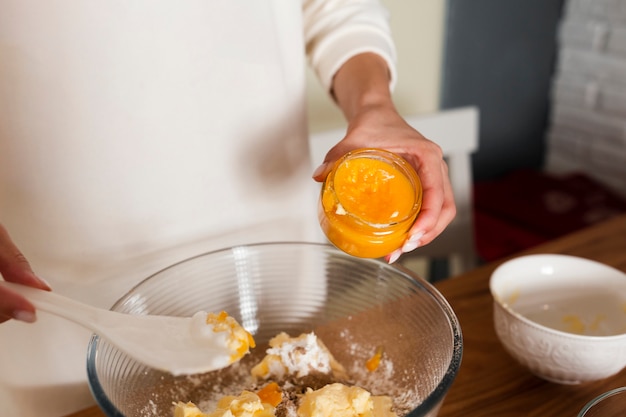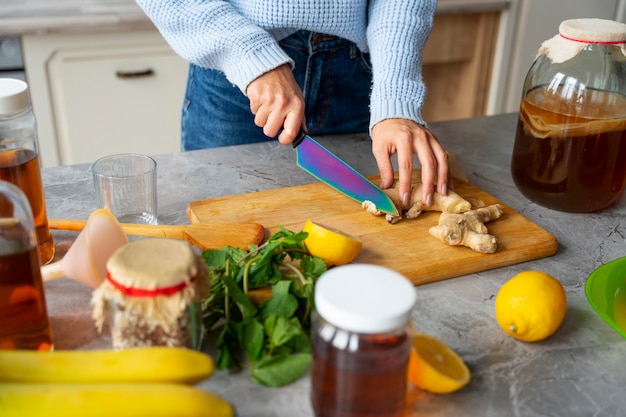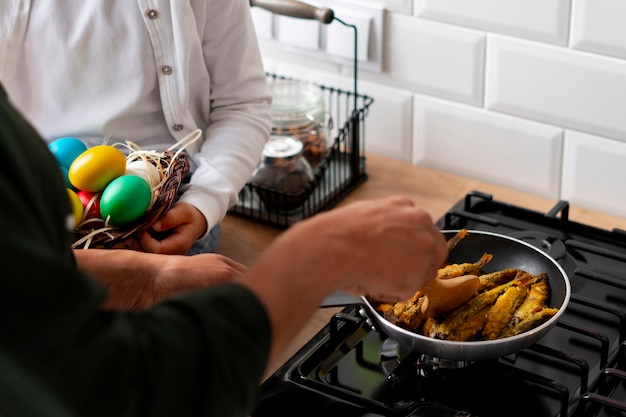(Part 1) The Importance of Choosing the Right Oil

Imagine you're about to whip up a stir-fry. You grab the first bottle of oil you see - perhaps a generic vegetable oil - and get to work. But then, you notice something... the aroma of your stir-fry isn't quite right, and the vegetables are starting to turn brown too quickly. You've unknowingly chosen an oil with a low smoke point, and the high heat has caused it to break down, releasing unpleasant flavours and aromas.
That's why choosing the right oil for the job is crucial. Some oils are ideal for high-heat cooking, while others are best suited for delicate tasks like drizzling on salads or finishing a dish. It's all about understanding the unique properties of each oil and knowing how to use them effectively.
Smoke Point – The Crucial Factor
The smoke point of an oil refers to the temperature at which it starts to break down and produce smoke. This breakdown can alter the flavour and aroma of your dish and even generate harmful compounds. When oil reaches its smoke point, it begins to decompose, creating a distinct acrid smell and altering the flavour of your food. This can be particularly noticeable in delicate dishes where the flavour is paramount.
Think of it this way: imagine using an oil with a low smoke point for high-heat frying. The oil might end up tasting burnt and acrid, ruining your dish. That's why understanding the smoke point of different oils is essential for achieving the best possible results.
The Importance of Understanding Oil Properties
Beyond the smoke point, consider the oil's flavour, texture, and nutritional profile. Choosing the right oil can enhance your dish, creating a symphony of flavours and textures.
For instance, extra virgin olive oil boasts a delicate flavour and vibrant aroma, making it perfect for drizzling over salads or finishing pasta dishes. The fruity notes and peppery hints of extra virgin olive oil complement the subtle flavours of these dishes, creating a harmonious culinary experience.
On the other hand, refined vegetable oils like canola oil are virtually flavourless and have a high smoke point, making them suitable for high-heat frying. Their neutral flavour allows the flavours of your food to shine through without any interference, making them ideal for dishes where you want the food to be the star of the show.
(Part 2) Common Oils and Their Smoke Points

Let's delve deeper into the world of oils and explore some of the most popular options, along with their smoke points. This will help you make informed decisions when choosing the right oil for your cooking needs.
- Smoke Point: 520°F (271°C)
- Ideal for: High-heat cooking, frying, baking, and roasting
- Flavour Profile: Mild, slightly nutty
- Health Benefits: Rich in monounsaturated fats and antioxidants
- Additional Information: Avocado oil's high smoke point and neutral flavour make it a versatile choice for various cooking methods. It's also a good source of healthy fats and antioxidants, making it a nutritious option.
Canola Oil
- Smoke Point: 400°F (204°C)
- Ideal for: Frying, baking, and sautéing
- Flavour Profile: Neutral
- Health Benefits: Low in saturated fat and high in monounsaturated fats
- Additional Information: Canola oil's high smoke point and neutral flavour make it a popular choice for everyday cooking. It's also a good source of heart-healthy fats.
- Smoke Point: 350°F (177°C)
- Ideal for: Baking, sautéing, and frying (at lower temperatures)
- Flavour Profile: Slightly sweet, nutty
- Health Benefits: Rich in medium-chain triglycerides (MCTs)
- Additional Information: Coconut oil adds a distinct sweet, nutty flavour to dishes. It's best used at lower temperatures, as it can become quite flavourful when heated to high temperatures.
Extra Virgin Olive Oil
- Smoke Point: 374°F (190°C)
- Ideal for: Drizzling, salad dressings, and finishing dishes
- Flavour Profile: Fruity, peppery, and slightly bitter
- Health Benefits: High in monounsaturated fats and antioxidants
- Additional Information: Extra virgin olive oil is a staple in Mediterranean cuisine. Its vibrant flavour and aroma are best enjoyed in dishes where the oil is not subjected to high heat.
Grapeseed Oil
- Smoke Point: 420°F (216°C)
- Ideal for: Frying, sautéing, and baking
- Flavour Profile: Neutral
- Health Benefits: High in polyunsaturated fats and antioxidants
- Additional Information: Grapeseed oil is a lighter oil with a high smoke point, making it suitable for various cooking methods. It's also a good source of antioxidants.
Peanut Oil
- Smoke Point: 450°F (232°C)
- Ideal for: Deep frying, stir-frying, and sautéing
- Flavour Profile: Mild, slightly nutty
- Health Benefits: High in monounsaturated fats and vitamin E
- Additional Information: Peanut oil is a popular choice for deep frying, thanks to its high smoke point and neutral flavour. It also has a longer shelf life than many other oils.
Sesame Oil
- Smoke Point: 410°F (210°C)
- Ideal for: Stir-frying, marinades, and dressings
- Flavour Profile: Nutty, toasty
- Health Benefits: Rich in antioxidants and omega-6 fatty acids
- Additional Information: Sesame oil's distinct nutty, toasty flavour adds a unique dimension to dishes. It's often used in Asian cuisine, both for cooking and for flavouring.
Sunflower Oil
- Smoke Point: 450°F (232°C)
- Ideal for: Frying, baking, and roasting
- Flavour Profile: Neutral
- Health Benefits: High in vitamin E and linoleic acid
- Additional Information: Sunflower oil is a versatile oil with a high smoke point, making it suitable for various cooking methods. It's also a good source of vitamin E and linoleic acid, a healthy omega-6 fatty acid.
(Part 3) The Ideal Cooking Temperatures for Different Oils

Now that we've explored the smoke points of various oils, let's move on to the optimal cooking temperatures for different methods. By understanding these ideal temperatures, you can ensure that your food cooks evenly and develops the desired flavour and texture.
Sautéing
Sautéing is a quick and versatile cooking technique that involves cooking food in a small amount of oil over medium-high heat. It's ideal for vegetables, proteins, and even some fruits. To achieve the perfect sauté, use an oil with a moderate smoke point, like canola oil, grapeseed oil, or avocado oil. These oils can withstand the medium-high heat required for sautéing without breaking down. Aim for a temperature between 350°F to 375°F (177°C to 190°C).
You'll know your oil is ready when it shimmers and just starts to smoke slightly. At this temperature, your food will cook quickly, creating a beautiful golden brown colour and retaining its crispness.
Frying
Frying involves immersing food in hot oil to cook it evenly. This method produces crispy exteriors and tender interiors, making it ideal for creating fried chicken, fish, and vegetables.
For deep frying, use an oil with a high smoke point, such as peanut oil, sunflower oil, or avocado oil. These oils can handle the high temperatures required for deep frying without breaking down, ensuring even cooking and crispy results. The ideal temperature range for deep frying is between 350°F to 375°F (177°C to 190°C).
If your oil isn't hot enough, your food will absorb too much oil and become greasy. If it's too hot, your food will burn on the outside before it's cooked through.
For shallow frying, you can use a slightly lower temperature, around 325°F (163°C). This is ideal for foods that require less time to cook, such as fish fillets, chicken breasts, or vegetables that need to be crisped up quickly.
Roasting
Roasting is a dry heat cooking method that involves cooking food in an oven. It's a versatile method that can be used for vegetables, meats, and even whole poultry. For roasting, you can use oils with moderate to high smoke points, such as canola oil, olive oil, or avocado oil. The ideal temperature for roasting is between 350°F to 400°F (177°C to 204°C).
The oil you choose will depend on the flavour profile of the dish. For example, olive oil adds a distinctive flavour to roasted vegetables, while canola oil is a neutral option for roasting meats.
Baking
Baking is a dry heat cooking method that involves cooking food in an oven. It's a great way to create cakes, cookies, bread, and other baked goods. For baking, you can use oils with a moderate smoke point, such as canola oil, olive oil, or avocado oil. The ideal temperature for baking varies depending on the recipe, but it’s usually between 325°F to 400°F (163°C to 204°C).
The type of oil you choose can impact the texture and flavour of your baked goods. For example, olive oil can add a subtle richness to cakes and cookies, while canola oil provides a neutral flavour that won't overpower the other ingredients.
(Part 4) My Personal Experiences with Oil and Temperature
As a seasoned cook, I've had my fair share of oil-related mishaps. I once attempted to deep fry chicken using olive oil, which resulted in a smoky kitchen and a batch of burnt chicken. This experience taught me the importance of using the right oil for the job.
Another time, I was trying to sauté vegetables in avocado oil, but I didn't heat the oil enough. The vegetables ended up steamed rather than sautéed. This experience emphasized the importance of heating the oil to the correct temperature.
(Part 5) Tips for Determining the Ideal Oil Temperature
Now, let's talk about how to ensure your oil reaches the right temperature. There are a few tried-and-true methods to help you determine if your oil is ready for cooking.
Using a Thermometer
The most accurate way to determine oil temperature is to use a cooking thermometer. This is particularly helpful for deep frying, where maintaining a consistent temperature is essential. Insert the thermometer into the oil and wait a few seconds for the reading to stabilize. Once it reaches the desired temperature, you're ready to start cooking.
The Water Test
If you don't have a thermometer, a simple water test can help you estimate the oil's temperature. Drop a small amount of water into the oil. If it sizzles and dances around, the oil is ready. If it sinks to the bottom and sits there, the oil is not hot enough.
The Breadcrumb Test
Similar to the water test, the breadcrumb test can help you assess the oil's temperature. Add a small piece of breadcrumb to the oil. If it sizzles and browns quickly, the oil is ready. If it takes a while to brown, the oil is not hot enough.
(Part 6) The Importance of Heating Oil Slowly
It’s essential to heat your oil slowly to prevent it from smoking and burning. Think of it as a gentle warm-up for your oil. Don't rush the process. Let the oil come up to temperature gradually, ensuring it’s evenly heated throughout. This will help prevent scorching and ensure that your food cooks evenly.
(Part 7) Safety Precautions When Using Oil
Oil can be dangerous if not handled properly. Always be cautious when working with hot oil and adhere to these safety precautions to ensure a safe cooking experience.
Never Leave Hot Oil Unattended
Always keep a watchful eye on your oil when it's heating or when food is being cooked. A moment's distraction can lead to a potential fire hazard.
Use a Pot with High Sides
This will help prevent splattering and spills. Hot oil splatters can cause severe burns, so using a pot with high sides will minimize the risk.
Wear Appropriate Clothing
Avoid loose-fitting clothing that could catch fire. Opt for close-fitting clothing that won't accidentally come into contact with the hot oil.
Keep a fire extinguisher Nearby
In case of a fire, you need to be prepared. Keep a fire extinguisher within easy reach, and know how to use it in case of an emergency.
Never Pour Hot Oil Down the Drain
This can cause clogs and plumbing problems. Instead, allow the oil to cool and dispose of it in a sealed container. This is a common mistake, but it can lead to costly plumbing issues.
(Part 8) Understanding the Different Types of Oil
As you explore the world of oils, you’ll come across various types, each with unique characteristics. Understanding these distinctions can help you choose the right oil for your culinary creations.
Virgin Oils
Virgin oils are extracted from the source material without using any chemicals or solvents. They retain their natural flavour and aroma, making them ideal for drizzling, salad dressings, and finishing dishes.
Think of virgin oils as the "natural" option. They retain their delicate flavours and aromas, adding a touch of sophistication to your dishes.
Refined Oils
Refined oils undergo a processing stage where they are bleached, deodorized, and refined to remove impurities and alter their flavour. Refined oils have a higher smoke point and are often neutral in flavour, making them suitable for high-heat cooking, frying, and baking.
Refined oils are the workhorses of the kitchen. They can withstand high heat without breaking down, making them ideal for frying, baking, and other high-heat cooking methods.
Blend Oils
Blend oils are a combination of virgin and refined oils, offering a balance of flavour and functionality. They are often a great option for everyday cooking, providing a delicate flavour without compromising the oil's smoke point.
(Part 9) The Art of Oil Blending
For those who enjoy experimenting, oil blending can be a fun and creative way to customize your cooking experience. You can blend different oils to create unique flavour profiles and tailor them to specific dishes. For instance, you could blend a mild oil like canola oil with a bolder oil like extra virgin olive oil for a flavourful yet functional cooking oil.
This blend would be suitable for both sautéing and finishing dishes, providing a subtle olive oil flavour without sacrificing the high smoke point of canola oil.
(Part 10) FAQs about Cooking Oils and Temperatures
Here are some frequently asked questions about cooking oils and temperatures:
What Happens if I Use an Oil with a Low Smoke Point for High-Heat Cooking?
Using an oil with a low smoke point for high-heat cooking will result in a smoky kitchen and a burnt or acrid-tasting dish. The oil will break down and produce harmful compounds, affecting the flavour and quality of your food.
Imagine trying to deep fry chicken using extra virgin olive oil. The oil would smoke heavily, producing a burnt flavour that would ruin your dish.
Can I Reuse Cooking Oil?
Reusing cooking oil is generally not recommended. As oil is heated, it breaks down and can develop harmful compounds. Each time you reuse oil, the smoke point decreases, and the quality deteriorates. For best results, use fresh oil for each cooking session.
The best practice is to dispose of used oil properly. Pour it into a sealed container and discard it in the trash.
How Do I Store Cooking Oil?
Store cooking oil in a cool, dark place away from direct sunlight and heat. Avoid storing oil near a stove or oven as this can cause the oil to become rancid.
Store your oils in a cool, dry cabinet away from the heat of the stove or oven. This will help preserve their freshness and flavour.
What is the Best Oil for Deep Frying?
Oils with a high smoke point, such as peanut oil, sunflower oil, or avocado oil, are best for deep frying. They can withstand high temperatures without breaking down, ensuring even cooking and crispy results.
Peanut oil is a classic choice for deep frying, while avocado oil offers a healthier option. Both have high smoke points and can withstand the heat without compromising flavour.
Can I Use Olive Oil for Frying?
While olive oil can be used for frying, it’s not the ideal choice for high-heat cooking. Extra virgin olive oil has a lower smoke point and a delicate flavour that can be compromised at high temperatures. It’s best to use olive oil for lower heat applications, such as sautéing or finishing dishes.
If you're looking for a flavourful oil for frying, consider using a blend of olive oil and a high-smoke point oil like avocado oil. This will allow you to enjoy the flavour of olive oil without sacrificing its functionality.
(Part 11) Conclusion
Understanding the best cooking temperatures for different oils is essential for achieving culinary success. Choosing the right oil for the job and heating it to the correct temperature will elevate your dishes to new heights. By following these tips and exploring the world of oils, you can unlock a new level of culinary creativity and enhance your cooking experience. Enjoy the journey, and happy cooking!
Everyone is watching

Corn on the Cob: The Ultimate Guide to Perfectly Cooked Ears
Healthy MealsAh, corn on the cob. Just the name evokes images of sunny days, barbecues, and that sweet, juicy flavour that ...

Perfect Pork Roast Oven Cooking Time: A Guide to Delicious Results
Healthy MealsThere's something truly satisfying about a perfectly roasted pork. The aroma alone is enough to make your mout...

Ham Cooking Time: How Long to Bake, Smoke, or Boil a Delicious Ham
Healthy MealsAh, ham. It's a classic, isn't it? A real crowd-pleaser, especially around holidays. And when done right, it'...

Scallops: The Ultimate Guide to Perfect Cooking
Healthy MealsAh, scallops. Those delicate, sweet, and utterly delicious morsels of the sea. They hold a special place in my...

Spaghetti Squash: The Ultimate Guide to Cooking and Serving
Healthy MealsRemember that time you saw spaghetti squash at the supermarket, looking all bumpy and strange, and thought, "W...
